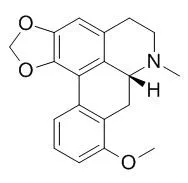| In vitro: |
| Food Chemistry,2011,124(4):1556-60。 | | Antimicrobial activity of extract and two alkaloids from traditional Chinese medicinal plant Stephania dielsiana[Reference: WebLink] |
METHODS AND RESULTS:
Two alkaloids, Stephanine and crebanine, were isolated from tubers of the traditional Chinese medicinal plant Stephania dielsiana, using an activity-directed isolation method, and inhibitory activity of methanol extract, Stephanine and crebanine against ten animal pathogenic bacteria and eight plant pathogenic fungi was evaluated in vitro. The results showed that extract from S. dielsiana exhibited high inhibitory activity against five gram-positive and four gram-negative animal pathogenic bacteria, with MIC values of 0.625-7.5g/l; Stephanine and crebanine had high inhibitory activity against gram-positive animal pathogenic bacteria, with MIC values of 0.078-0.312g/l, but low inhibitory activity against gram-negative animal pathogenic bacteria.
CONCLUSIONS:
Methanol extract, Stephanine and crebanine also inhibited hyphal growth of the plant pathogens Cercospora kaki, Gymnosporangium haraeanum, Pyricularia oryzae, Rhizoctonia solani and Colletotrichum graminicola, and spores germination of Thielaviopsis paradoxa, Fusarium oxysporum f. sp. niveum, Sphaceloma fawcettii and G. haraeanum. | | J Ethnopharmacol. 2013 Jan 9;145(1):381-5. | | New antiplasmodial alkaloids from Stephania rotunda.[Pubmed: 23127648 ] |
METHODS AND RESULTS:
A new aporphine alkaloid named vireakine (2) along with two known alkaloids Stephanine (1) and pseudopalmatine (8), described for the first time in Stephania rotunda, and together five known alkaloids tetrahydropalmatine (3), xylopinine (4), roemerine (5), cepharanthine (6) and palmatine (7) were isolated and identified. The structure of the new alkaloid was established on the basis of 1D and 2D NMR experiments and mass spectrometry. The compounds were evaluated for their in vitro antiplasmodial and cytotoxic activities. All tested compounds showed significant antiplasmodial activities with IC(50) ranged from 1.2 μM to 52.3 μM with a good selectivity index for pseudopalmatine with IC(50) of 2.8 μM against W2 strain of Plasmodium falciparum and IC(50)>25 μM on K562S cells.
CONCLUSIONS:
This study provides evidence to support the use of Stephania rotunda for the treatment of malaria and/or fever by the healers. Alkaloids of the tuber exhibited antiplasmodial activity and particularly cepharanthine and pseudopalmatine. |
|






 Cell. 2018 Jan 11;172(1-2):249-261.e12. doi: 10.1016/j.cell.2017.12.019.IF=36.216(2019)
Cell. 2018 Jan 11;172(1-2):249-261.e12. doi: 10.1016/j.cell.2017.12.019.IF=36.216(2019) Cell Metab. 2020 Mar 3;31(3):534-548.e5. doi: 10.1016/j.cmet.2020.01.002.IF=22.415(2019)
Cell Metab. 2020 Mar 3;31(3):534-548.e5. doi: 10.1016/j.cmet.2020.01.002.IF=22.415(2019) Mol Cell. 2017 Nov 16;68(4):673-685.e6. doi: 10.1016/j.molcel.2017.10.022.IF=14.548(2019)
Mol Cell. 2017 Nov 16;68(4):673-685.e6. doi: 10.1016/j.molcel.2017.10.022.IF=14.548(2019)